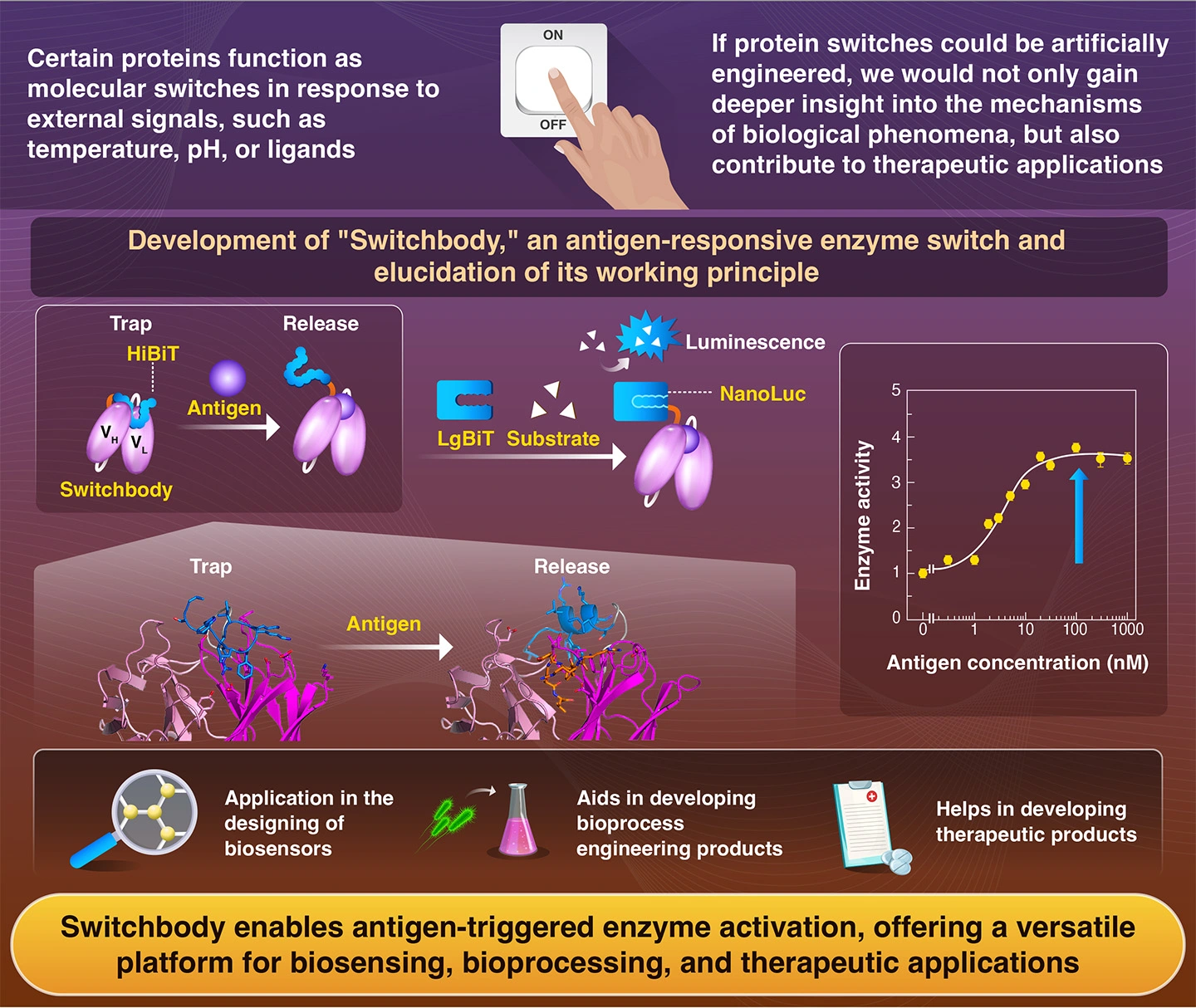By fusing enzyme fragments to antibodies, researchers from Institute of Science Tokyo, Japan, developed an innovative enzyme switch "Switchbody," which is activated when bound to its target antigen. Switchbody is based on a trap-and-release of enzyme fragment that dynamically controls enzyme activity, offering new opportunities in diagnostics, therapeutics, and precision bioprocessing.
Switchbody: Turning Antibody-Antigen Binding into an Enzyme Activity

Proteins that respond to external stimuli function as molecular switches, playing a vital role in the precise regulation of biological processes. Therefore, if protein switches could be artificially engineered to freely control cellular physiological function, we would not only gain deeper insight into mechanism of biological phenomena, but also contribute to therapeutic application by restoring impaired cellular functions. Although artificial protein switches have been developed, the rational design of proteins capable of turning their activity on or off remains a long-standing challenge in biochemistry.
Addressing this gap, a team of researchers led by Associate Professor Tetsuya Kitaguchi and Assistant Professor Takanobu Yasuda at the Laboratory for Chemistry and Life Science, Institute of Integrated Research, Institute of Science Tokyo (Science Tokyo), Japan, in collaboration with Assistant Professor Masahiko Taguchi from Tohoku University, Japan; Dr. Takanori Kigawa from RIKEN, Japan; and Professor Ryoichi Arai from Shinshu University, Japan; has developed a novel antibody-based enzyme switch called "Switchbody," which is activated upon antigen binding and elucidated its working principle for rational design. The findings were published online in the journal Advanced Science on September 15, 2025.
As the molecular recognition element, the researchers employed an antibody that binds to the 7 amino acids peptide derived from the Bone Gla Protein. As a protein for introducing switching function, they adopted split NanoLuc, which is a bioluminescent enzyme composed of two parts; HiBiT, a short fragment consisting of 11 amino acids, and its complementary large fragment, LgBiT. Although each fragment is inactive on its own, they reconstitute into a functional NanoLuc that produces bright bioluminescence by catalyzing a substrate.
To develop the Switchbody, the researchers fused an antibody with the HiBiT. This fusion enabled enzyme activity when the antibody would bind to its target antigen. The underlying working principle relies on a "trap-and-release" process.
"In the absence of antigens, the fused HiBiT is trapped within the antibody," explains Kitaguchi. "Antigen binding triggers its release, allowing HiBiT to pair with its complementary fragment, LgBiT, thereby restoring the enzyme's bioluminescence-producing activity."
To understand the mechanism of this process, the team performed thorough investigation using a combination of advanced analytical techniques, including ELISA, X-ray crystallography, NMR spectroscopy, and molecular dynamics simulations. These analyses revealed that, in the absence of antigen, the HiBiT interacts with key amino acids near the antigen-binding site. Upon antigen binding, these interactions are disrupted, increasing motility of HiBiT to form an active enzyme complex with LgBiT. These insights into its mechanism have opened the way to the rational design of Switchbody.
In essence, the approach turns an enzyme into a smart molecular switch that is activated by antigen, offering a powerful new strategy for not only detecting biological molecules but also regulation of cellular physiological functions by employing enzymes involved in key processes such as signal transduction and metabolism. Additionally, the researchers also developed a probe that can assemble with unmodified antibodies to form a Switchbody. This probe was achieved by fusing HiBiT to an antibody-binding protein known as "Protein M." This remarkable adaptation opens new avenues for a wide range of commercially available antibodies to be converted into antigen-responsive enzyme switches.
"We believe this technology could be applied in biosensing, bioprocess, and therapeutic applications," says Kitaguchi. "In the future, we would like to expand Switchbodies to control multiple cellular functions simultaneously, enabling real-time regulation of biochemical pathways."
Reference
- Authors:
- Takanobu Yasuda1, Yoshiyuki Ueno2, Masahiko Taguchi3, Naoya Tochio4, Hiromasa Yagi4, Shuma Yazaki5, Ryoichi Arai5,6, Bo Zhu1, Takanori Kigawa4, Hiroshi Ueda1, and Tetsuya Kitaguchi1*
*Corresponding author
- Title:
- Switchbody, an Antigen-Responsive Enzyme Switch Based on Antibody and Its Working Principle
- Journal:
- Advanced Science
- Affiliations:
- 1Laboratory for Chemistry and Life Science, Institute of Integrated Research, Institute of Science Tokyo, Japan
2Graduate School of Life Science and Technology, Institute of Science Tokyo, Japan
3Institute of Multidisciplinary Research for Advanced Materials, Tohoku University, Japan
4Laboratory for Cellular Structural Biology, Center for Biosystems Dynamics Research RIKEN, Japan
5Department of Applied Biology, Faculty of Textile Science and Technology Shinshu University, Japan
6Division of Life Innovation, Institute for Biomedical Sciences, Interdisciplinary Cluster for Cutting Edge Research, Shinshu University, Japan






